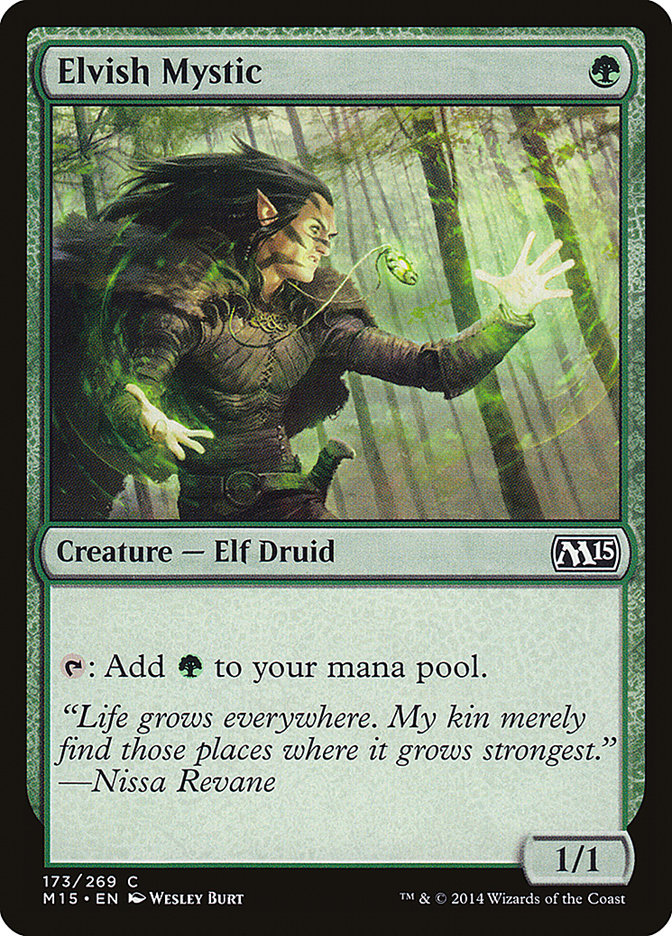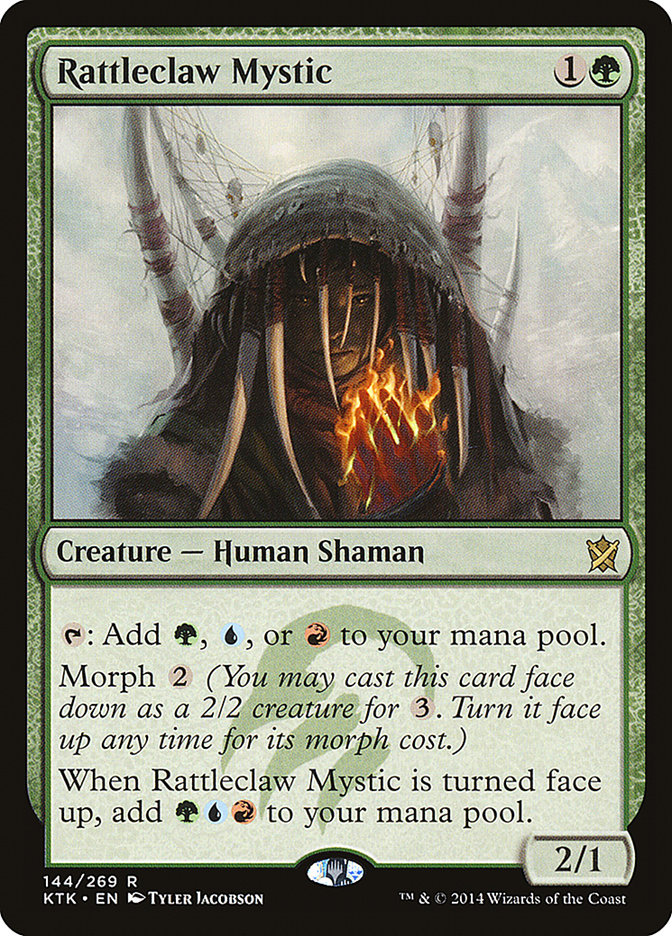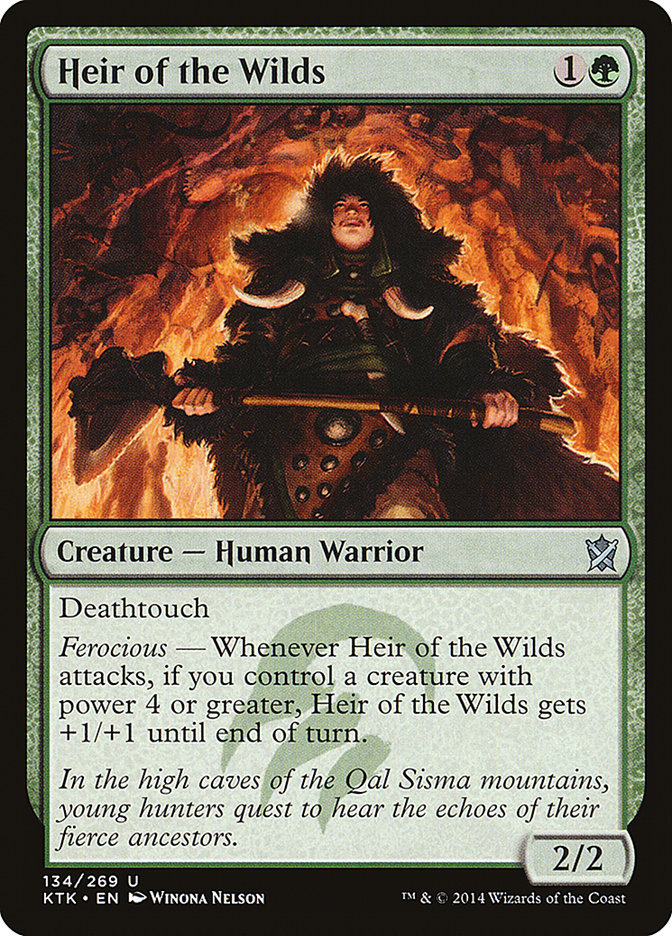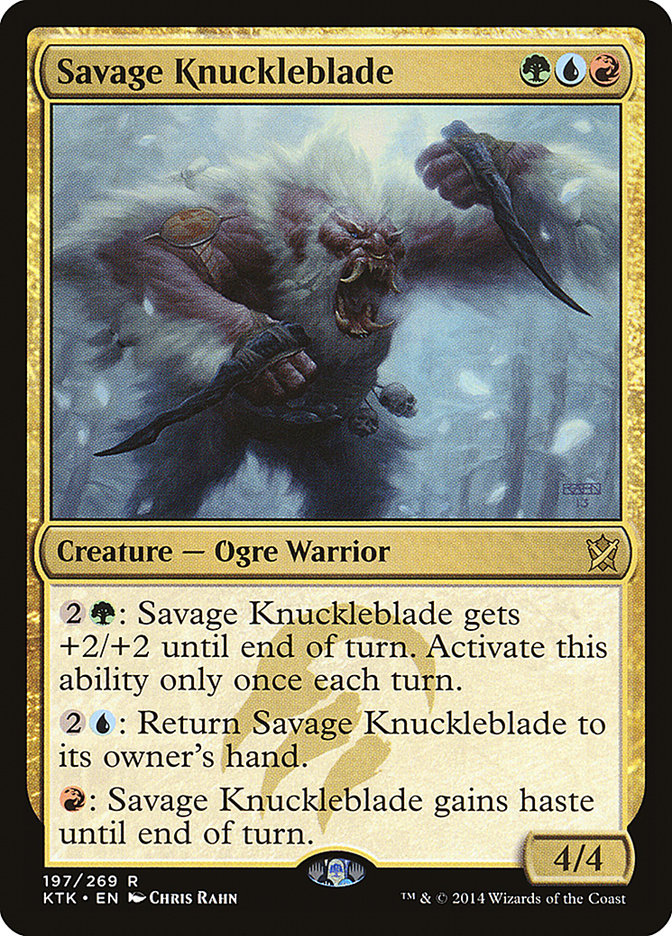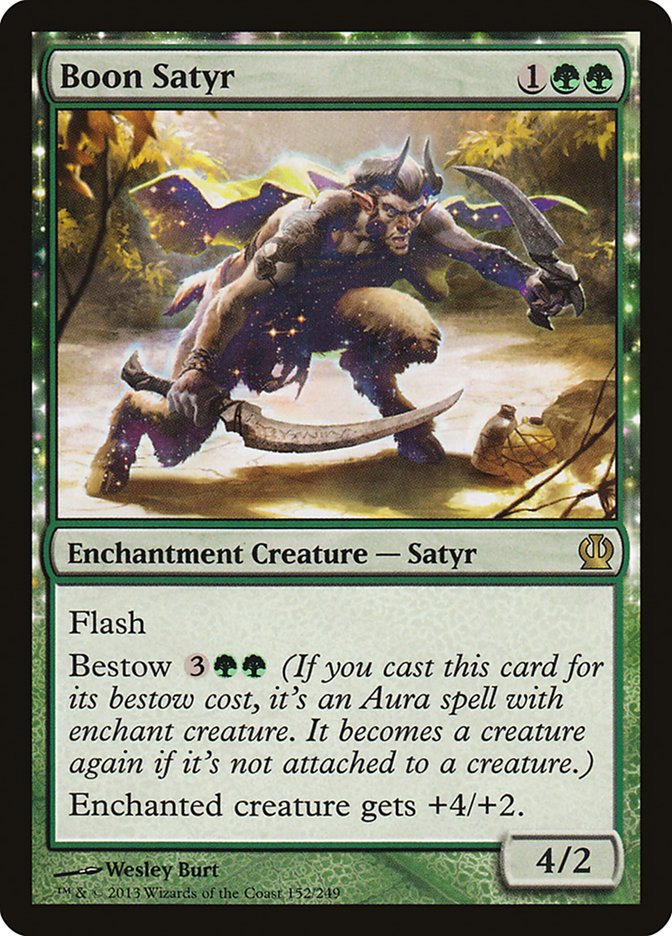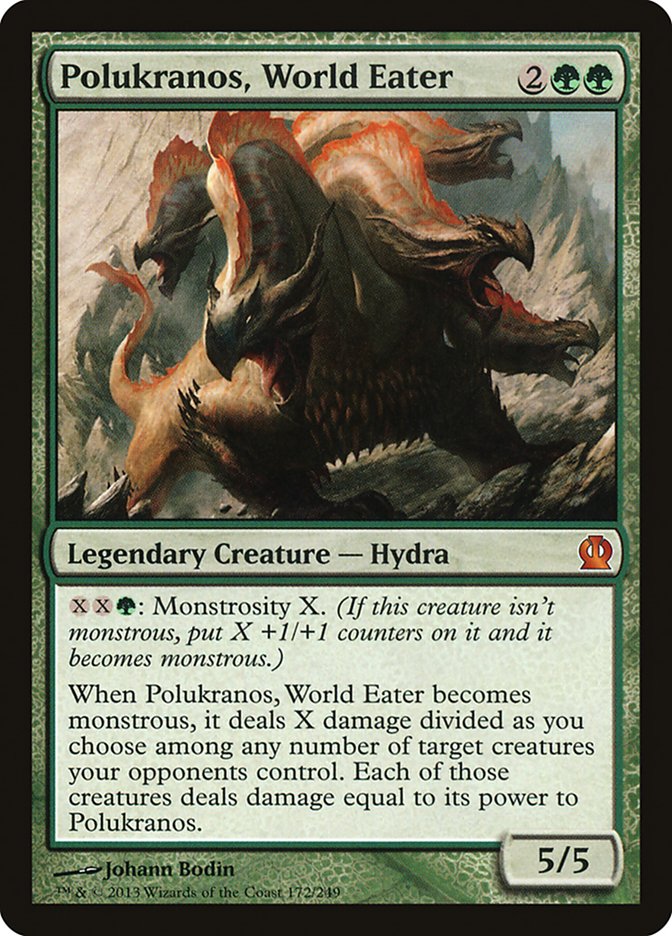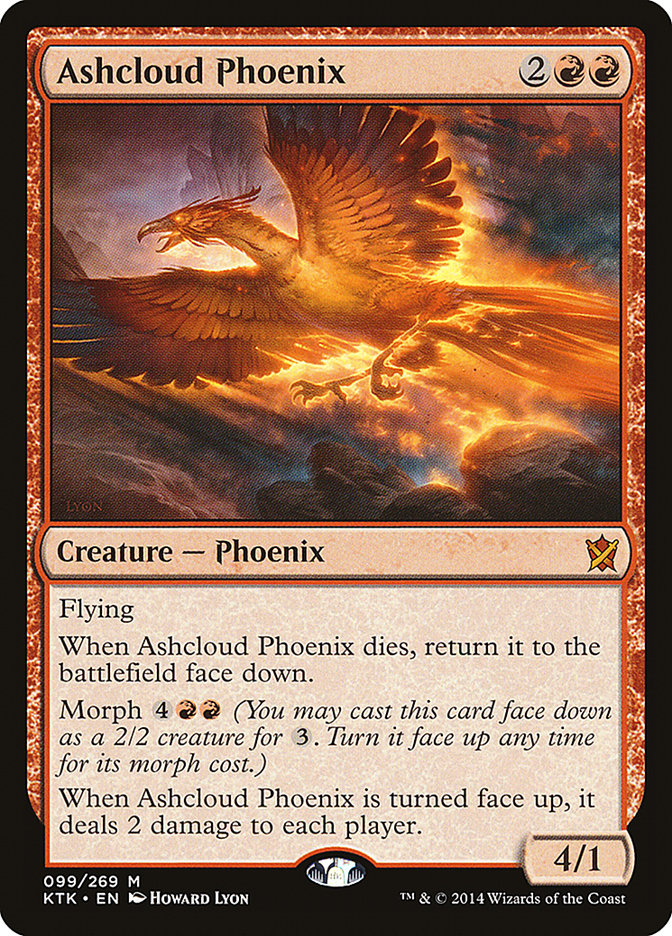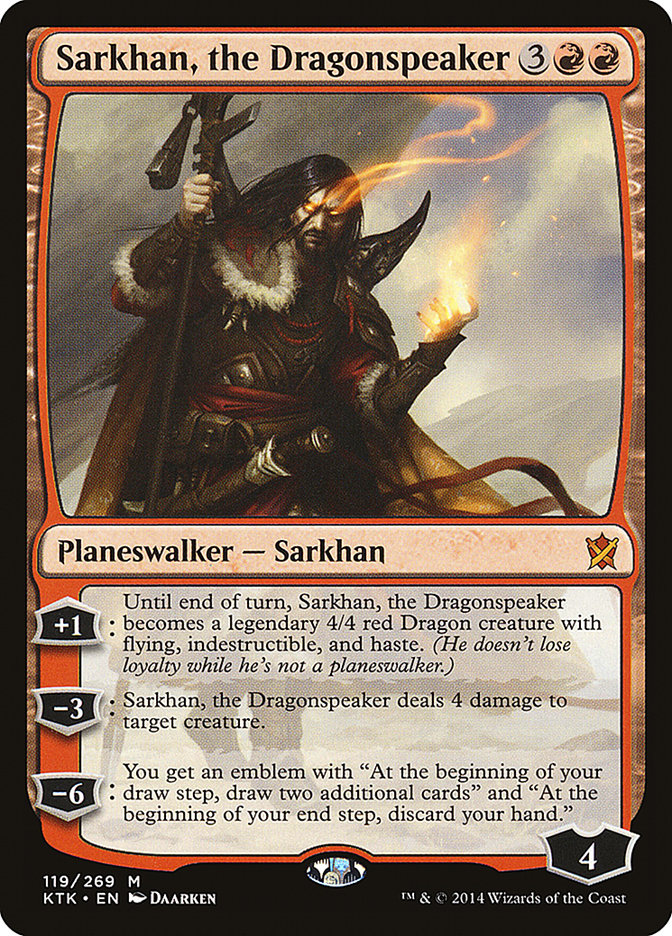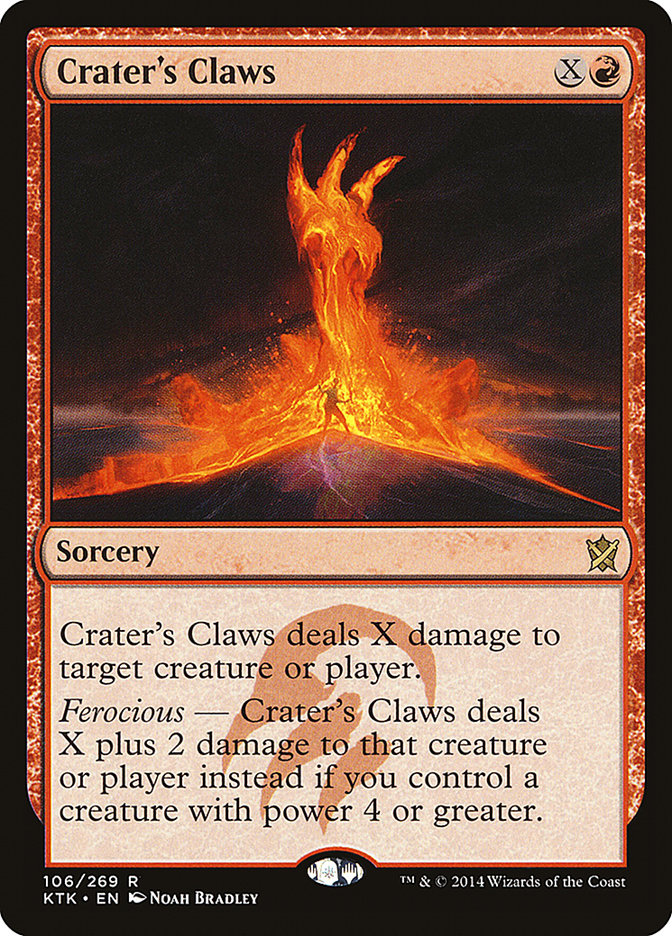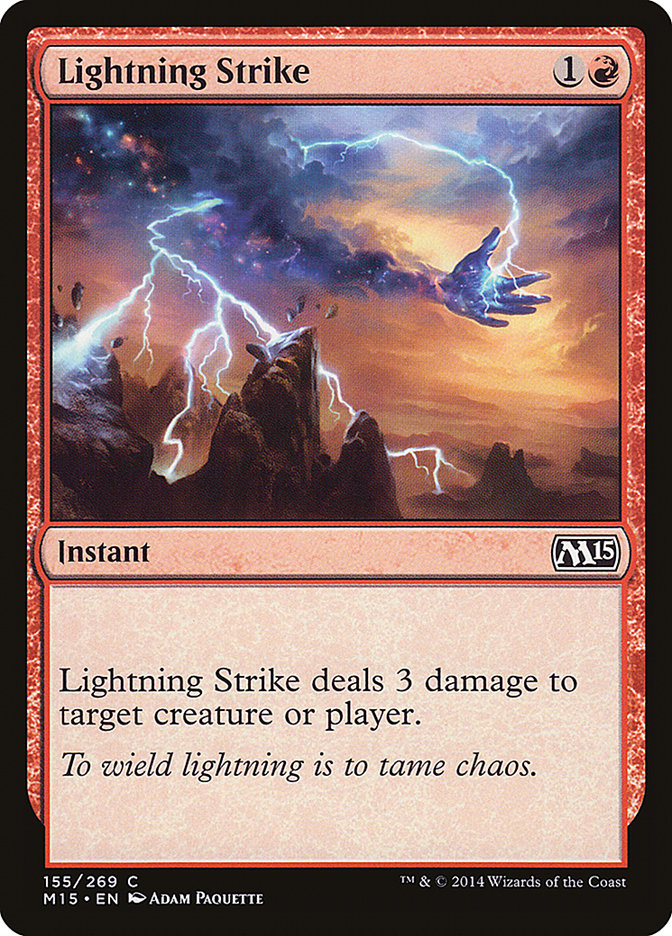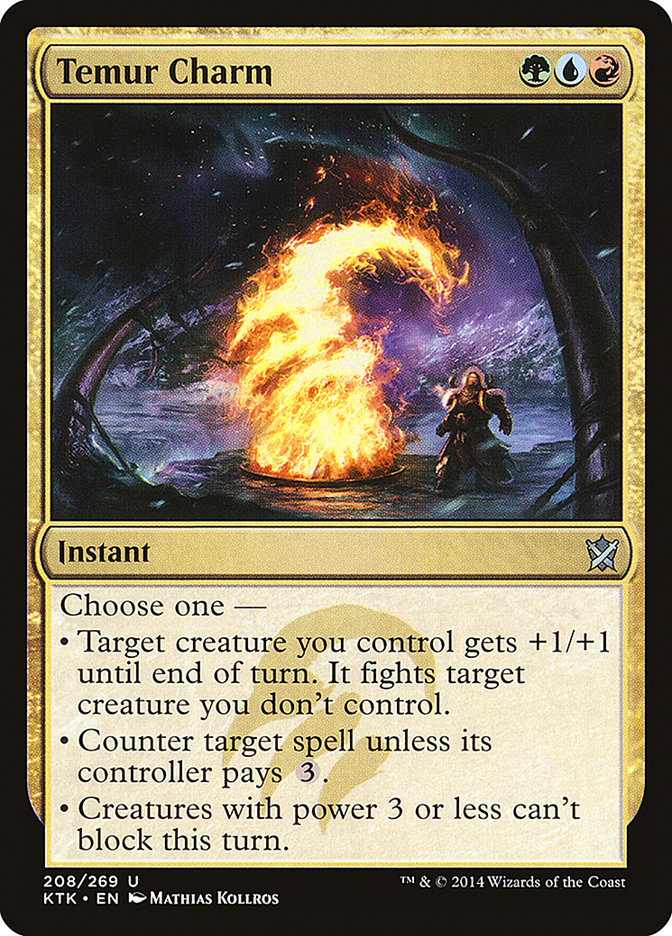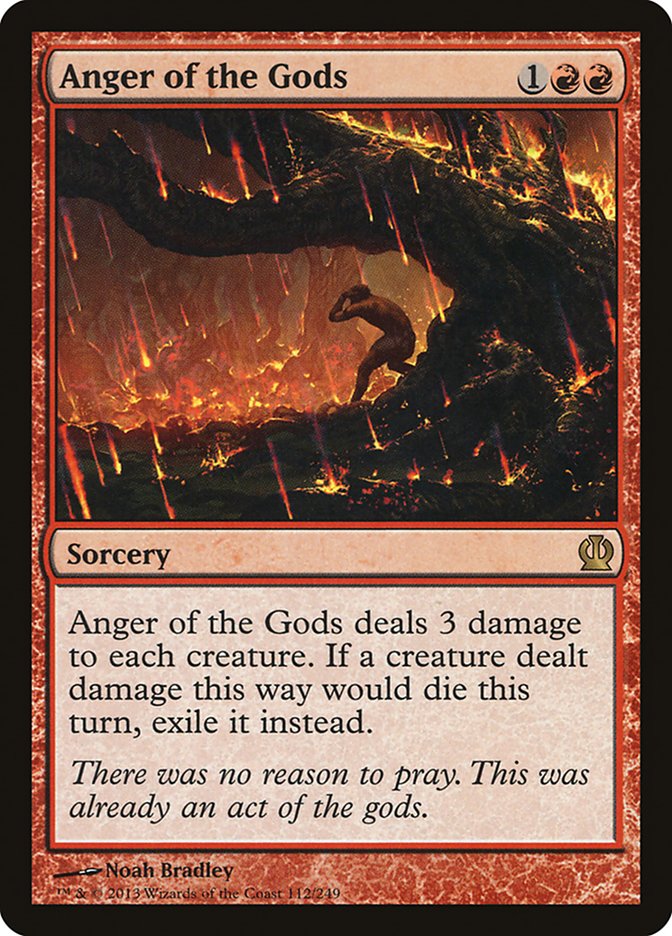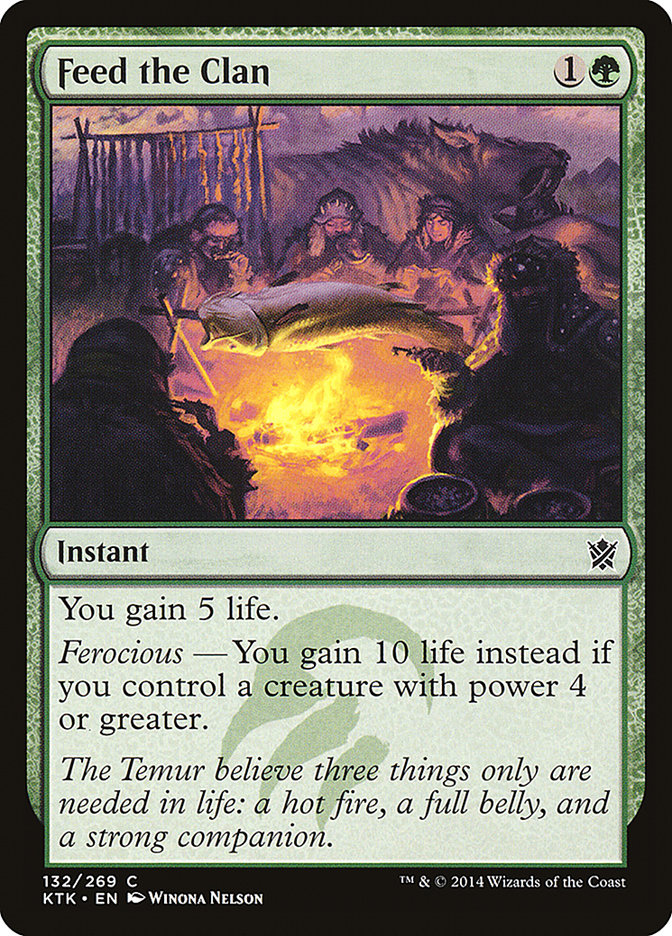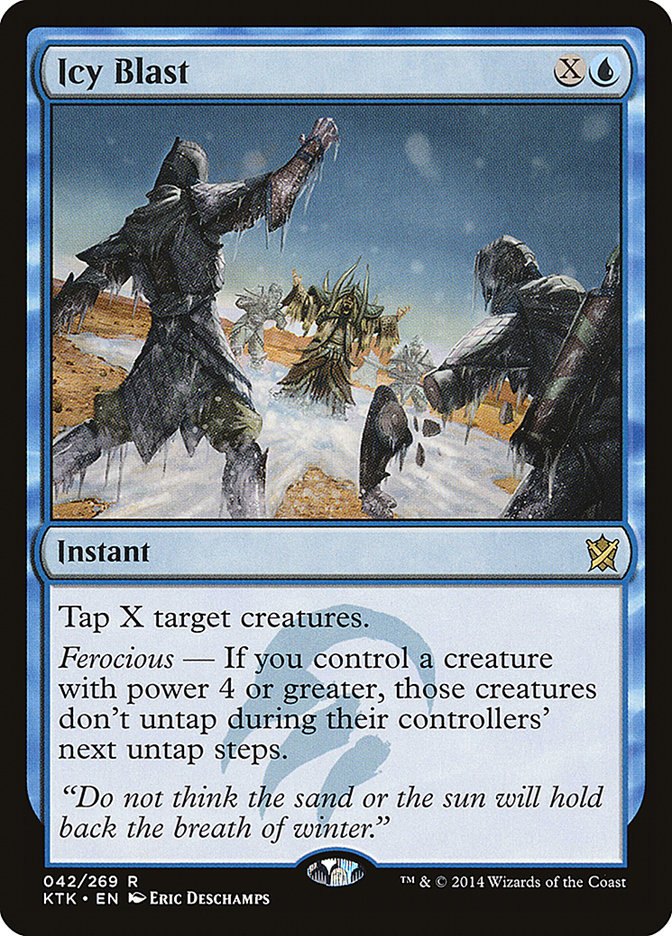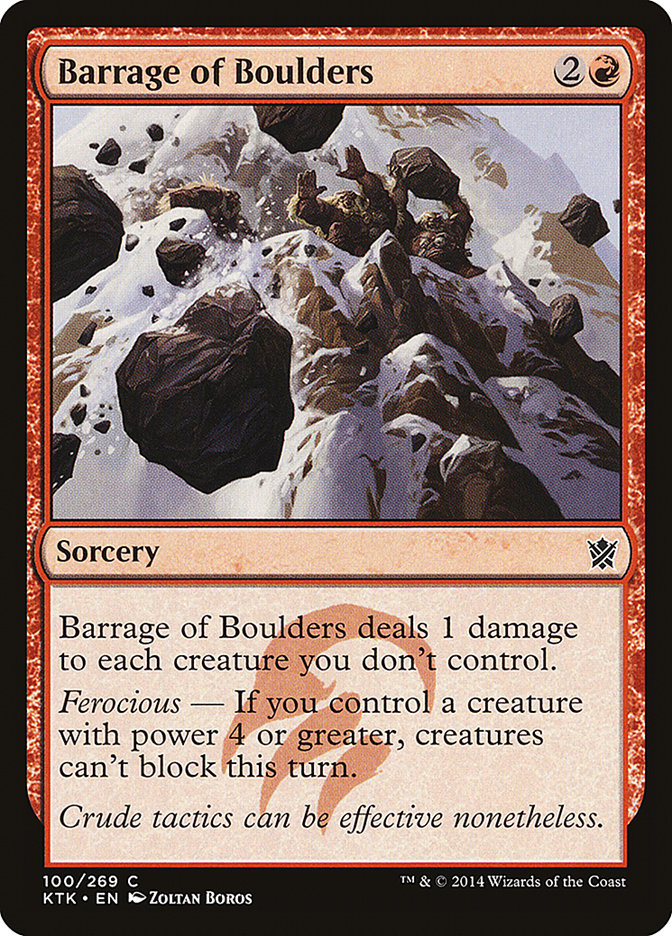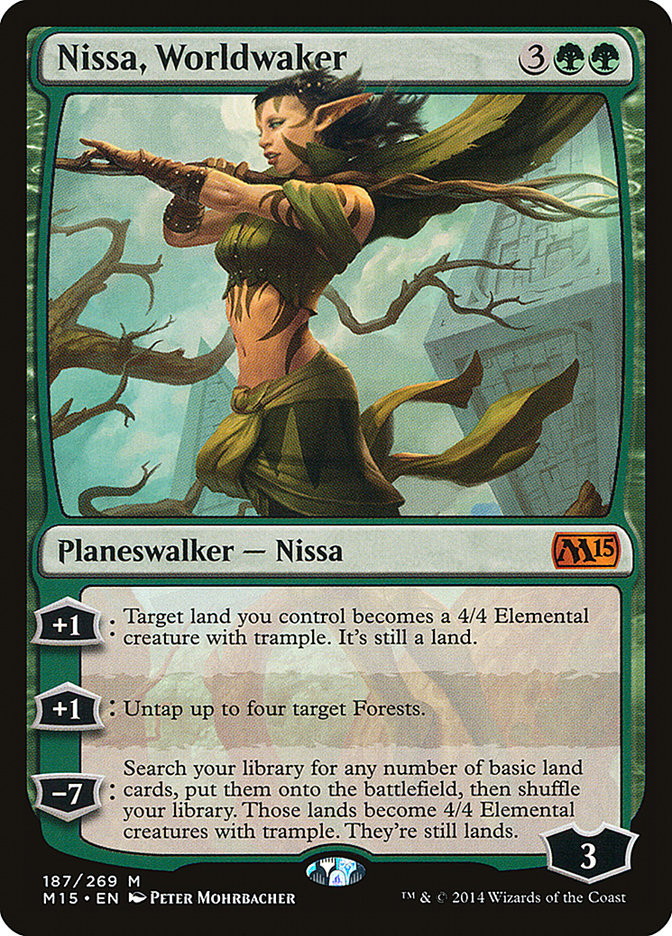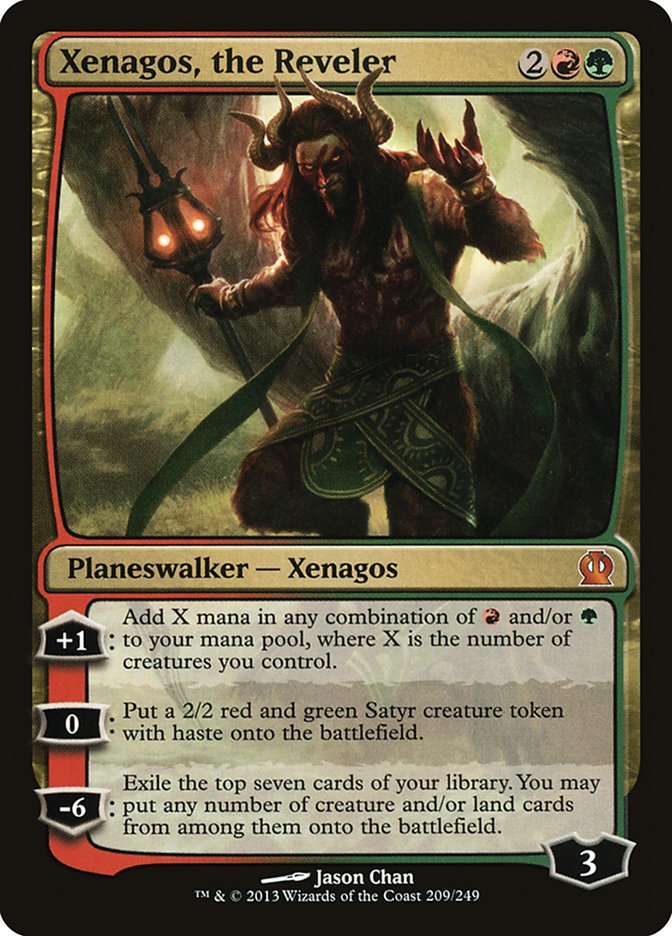When I woke up to my alarm blaring last Saturday morning, I almost just turned it off and went back to sleep. I had gotten back from my trip to Hawaii late
the night before, and I certainly wasn’t pleased to be woken up at what would have been 5:00am where I’d been just 24 hours earlier.
There was a brief struggle inside my brain. On the one hand, I hadn’t played a game of Magic since the Pro Tour, so I couldn’t be sure how the new metagame
was shaping up or if my deck was really any good at all. On the other hand, there was a Grand Prix within driving distance of my apartment, and whether I
had the testing results to back it up or not, I thought my Temur deck was really sweet and wanted a chance to play it.
In the end, the desire to play a sweet deck won out over my desire to stay in bed, and I’m very glad it did.
Here’s what I played at Grand Prix L.A:
Creatures (26)
- 4 Elvish Mystic
- 3 Polukranos, World Eater
- 4 Boon Satyr
- 4 Rattleclaw Mystic
- 4 Heir of the Wilds
- 4 Savage Knuckleblade
- 3 Ashcloud Phoenix
Planeswalkers (1)
Lands (23)
Spells (10)

(The list I ultimately played was just a few cards off from the list from my article last week between the maindeck and sideboard. You too, could have
played my Temur deck at the Grand Prix!)
After the first day, I was in first place at 9-0, which was certainly a good feeling. I had a string of disappointing results last year, with several poor
Pro Tour performances and only a few decent Grand Prix finishes. I didn’t make a single Top 8 at either a Pro Tour or a Grand Prix all season, the first
such period for which that has been true since I started playing again back in 2009. I’m only half-joking when I blame Lifebane Zombie for my lack of
success, since I stubbornly continued to play green creature decks in tournaments the entire time the card was legal.
I was hoping to get on the board with a Top 8 finish early this season after my day one start, but unfortunately it was not to be. I took a pair of close
losses early in the day to Isaac Sears and Brad Nelson, then rattled off three straight wins to stay in the hunt going into the last round. I was actually
in a position where I could have drawn in based on match points and tiebreaker math, but my opponent in the final round – Eric Pei – unfortunately was not.
I told him I’d happily accept a draw if he would give me one, but explained that it was certainly not in his best interests. Unsurprisingly, he turned me
down, and then dispatched me handily with his Mono-Red deck.
Those games in my win-and-in match were actually the first I’d ever played with Temur against Mono-Red. Aggressive decks outside of Jeskai weren’t a major
part of our gauntlet for the Pro Tour, so Mono-Red certainly wasn’t among the handful of decks I actually tested against in my very limited practice time.
When Frank Karsten had interviewed me for a deck tech after my 9-0 day one finish, he asked me what my bad matchups were, and I told him that I wasn’t
really sure, but it seemed like I was probably a dog to aggressive red decks. Turns out my theory was right!
Anyway, let’s back up a little bit and take a look at the deck itself. I discussed how I came to the overall structure of this deck last week, but I want to go into a bit more detail about the
individual cards themselves, both in terms of their role in the deck now, and my thoughts about their inclusion moving forward.
To put what I’m about to say in context, let me show you a snapshot of the Notes app on my iPhone.
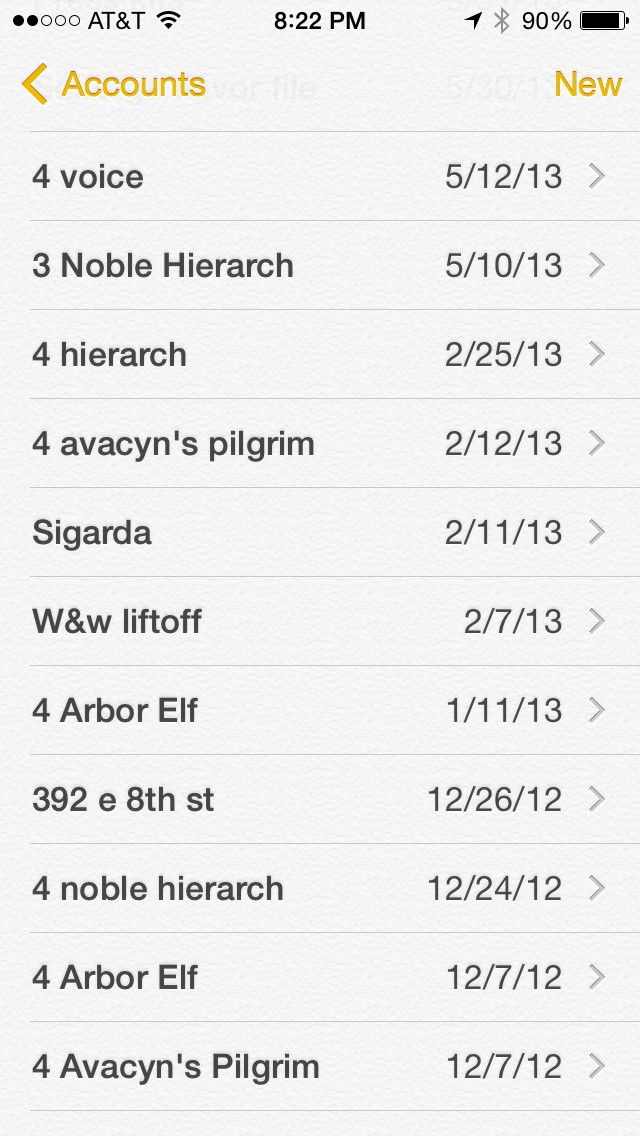
Suffice it to say that I build a lot of decks with a lot of mana accelerants in them. What can I say? I like ramping into monsters, and one drop mana elves
have been the best way to do that since pretty much the dawn of time.
Except when they’re not. As strange as it may seem, I’m not certain that this is a deck that wants four copies of Elvish Mystic. At the Pro Tour, I played
Elvish Mystics and only three Rattleclaw Mystics (as a side note – is it annoying to anyone else that both mana creatures are “X Mystic”? It makes it so
much more difficult to refer to them in shorthand. I’ll be calling them “Elves” and “Rattleclaws” to avoid confusion), and I think that split was certainly
incorrect.
Rattleclaw Mystic plays an important role in the deck as not only a mana accelerant, but also as a mana fixer. There are a lot of color intensive cards in
this deck, and your landbase can certainly use a little help casting them. Rattleclaw Mystic helps a tremendous amount when it comes to casting Savage
Knuckleblade and giving it haste, or playing Temur Charm or Ashcloud Phoenix.
Elvish Mystic doesn’t do that. It can only ramp you into a turn 2 Knuckleblade if you draw a Yavimaya Coast or Mana Confluence along with another land that
isn’t a basic Forest. If you do play basic Forest into Elvish Mystic, you still need two other colored sources to cast either Knuckleblade or Ashcloud
Phoenix (face-up, at least), which makes the ramp it provides you less valuable than it might be in some other decks.
That being said, your best draws are still those that contain Elvish Mystic. Even if you have the opportunity to play Elvish Mystic into Heir of the Wilds
plus tapped land into turn 3 Phoenix or Polukranos, you’re pretty excited. But it isn’t as powerful as it might be in other decks that can easily use it to
play powerful three drops. My earliest versions of the deck had Goblin Rabblemaster, and then Fanatic of Xenagos, both of which made Elvish Mystic much
more powerful than Rattleclaw because of the explosive openings it enabled.
This is a very long-winded way of saying I think it’s possible that you only want to play three, or even two copies of Elvish Mystic, even while you
certainly want four copies of Rattleclaw. With a lower curve than many G/R decks, you’re not nearly as reliant on drawing mana accelerants to operate
effectively, and you don’t want as many low impact cards to draw late in the game.
Speaking of low-impact draws, I’ve had a lot of people ask me why I play Rattleclaw Mystic over Sylvan Caryatid when the latter is much sturdier and more
likely to live. The reason is that Rattleclaw Mystic can attack for two, and in an aggressive deck, that’s a big deal. Sylvan Caryatid is certainly the
best option for decks that just want to ensure that they can rely on their mana accelerant surviving, because they’re going to use it to ramp into powerful
effects. This deck is much more about beating your opponent down from the get go, and a few hits from Rattleclaws here and there can really add up,
especially when you have burn to back them up.
This unassuming card is an absolute workhorse in this deck and probably one of the most underrated cards in all of Khans. One of the problems that
aggressive decks can run into in a world of midrange decks is its creatures getting outclassed. If you play a 2/2 or even a 3/3 on turn 2, it’s going to
have trouble getting past your opponent’s Courser of Kruphix, or even worse, their Siege Rhino or Polukranos.
Heir of the Wilds doesn’t have that problem. Thanks to its built-in deathtouch, Heir of the Wilds pretty much never gets outclassed. It can attack into
just about anything with impunity, and if you’re able to trigger ferocious, it hits pretty damn hard. And just like with Rattleclaw Mystic, those hits add
up, especially when you have tools to end the game in short order.
I can see potentially cutting one or even two copies of Heir, depending on the direction you want to go with the deck, but I’m generally in favor of
playing the full four. You really want to have something proactive to do in the first couple turns of the game. You’d generally rather play Rattleclaw than
Heir since it improves your options on future turns, but you’d much rather play Heir than nothing so you can start getting damage in as soon as possible.
Big Knucks. The Knuckleballer. Whatever you want to call him, this guy is an absolute monster and perhaps the biggest incentive to play Temur in Standard.
He hits hard, he hits fast, and he just keeps coming in, undaunted by even a Rhino on the opposite side of the table.
Remember what I said about Heir of the Wilds being valuable because it’s a cheap creature that doesn’t get outclassed? Well multiply that by one hundred
for Savage Knuckleblade. One of the most valuable traits a creature can have in a midrange deck with an aggressive slant (which is really the sort of decks
I always build) is the ability to be relevant both early and late in the game. Generally, this means the creature has some way in which it grows in power
as the game progresses, like Knight of the Reliquary’s +1/+1 for each land in your graveyard or Polukranos’s monstrosity ability.
Savage Knuckleblade has not one, not two, but three abilities. When you have three mana in play, it’s a 4/4 creature, which is decidedly ahead of
the curve already. At four mana, it’s a 4/4 with haste. At seven mana? 6/6 haste coming through! And that’s to say nothing of the blue ability to return
itself to your hand to dodge removal, which can force your opponent into making very awkward plays.
Knuckleballer is the real deal. It’s the most powerful creature in this deck, and this is a deck with Polukranos, which was already one of the most
powerful creatures in Standard. It’s no coincidence that he’s the face on one of the GP Nashville playmats at the end of the month – or that Rattleclaw
Mystic was featured on the playmat in LA! Wizards knew the power of Temur. Soon, the rest of the world will too.
Boon Satyr is probably the worst card in the deck. It’s a very flexible card, offering either a creature or enchantment at instant speed, which goes well
with Temur Charm, Lightning Strike, and the sideboarded countermagic. It’s a four power creature for three mana, which helps enable ferocious for both
Crater’s Claws and Stubborn Denial. All of these are good things, but they don’t necessarily make up for the fact that it’s a three mana creature that
trades with Magma Jet and lots of one drops.
That said, just because it’s the worst card in the deck doesn’t mean it shouldn’t be there. There’s a band of power levels within any deck – every deck has
a worst card. And as far as I’ve found, I still think it’s the best option available at the moment. I tried Goblin Rabblemaster, Fanatic of Xenagos, and
Courser of Kruphix, and wasn’t happy with any of them. But if there’s a new three drop option in the next set, Boon Satyr is the first card I’ll be looking
to replace with it.
I’m not 100% sure what the appropriate mix of big creatures is for the deck. As I mentioned in my article last week, I wasn’t happy with Stormbreath Dragon at
the Pro Tour, since five mana is a lot to pay for something that dies to Stoke the Flames. That’s even more of an issue now that Mono-Red has experienced a
resurgence – both the part about costing five and about dying to Stoke. The more expensive creatures are worse against decks that can kill your mana
accelerants, since you’re less likely to be able to cast them early (if at all), and they’re particularly bad when your opponent can easily kill them once
you actually get them into play.
That’s one of the reasons I’ve come to really like Ashcloud Phoenix. While it’s vulnerable to removal spells that Polukranos and Stormbreath Dragon are
not, like Magma Jet or Lightning Strike, you’re still getting value out of it if your opponent just flips it face down. I actually had a number of games at
the Grand Prix where I read my opponent for holding up a removal spell to cast at the end of my turn, and I just played Ashcloud Phoenix instead of a
Polukranos. This left them in the awkward position of effectively wasting their turn by not spending the mana they had left open, or getting poor value
from their Hero’s Downfall or similar effect by casting it on my Phoenix that would just threaten to come back later.
Additionally, as I mentioned last week, it’s important to keep in mind the fact that you can always play Phoenix face down if it’s appropriate to your
curve. The presence of Rattleclaw in the deck can help disguise it, so your opponent won’t necessarily just kill it on sight. And even if they do, that can
often mean a burn spell that isn’t aimed at your mana accelerants, which can allow you to follow up with a Polukranos or a face up Phoenix the following
turn. I won several games at the Grand Prix by flipping Phoenixes face up – both the 4/1 flying body and the damage trigger can do a lot of work to chip
away at an opponent’s life total.
That chipping away is especially effective due to the deck’s spell suite, which includes quite a few ways to finish off a wounded opponent. The best of
these cards, hands down, is Crater’s Claws. Crater’s Claws can be a powerful tempo play to kill your opponent’s two toughness creature for one mana if you
have a four power creature in play, and it can also just go to their face to finish them off.
Lightning Strike is the best of the lot against Jeskai, since it lines up so well against Rabblemaster and Mantis Rider in particular, but it’s fairly weak
against Abzan and other green decks. It’s good against the more aggressive versions with Fleecemane Lion and Raksasha Deathdealer, but lines up very poorly
against Courser of Kruphix and Siege Rhino.
Temur Charm is an odd card. It was initially one of my motivations for building the deck in the first place, but the more I play, the less I like it. The
big problem with it is that none of its modes are very good when you’re behind. Fighting is clearly only effective if you have a big enough creature on the
board. The Mana Leak mode needs you to have a board presence to be able to afford to leave mana untapped to counter your opponent’s spells. And the
semi-Falter mode is also clearly only good if you have a significant number of creatures in play.
It’s certainly a good card in a lot of situations, but there are also a lot of spots – and entire matchups – where it is something of a dud. I’m not sure
I’m ready to cut it from the deck entirely, because it fills a lot of roles and is one of your best answers to a lot of the cards that are otherwise great
against you, like Hornet Queen (with two of the three modes being great there), but it’s certainly a card that has not performed as well as others in the
deck.
I actually had a few copies of Stubborn Denial in the maindeck of one of my earliest versions of Temur, and it’s possible that it’s correct for them to
make it back in. If I were to add Denials to the maindeck, Temur Charm is certainly what I’d cut to make the space. A deck like this wants a very high
density of proactive threats, so you only want to play so many spells. I ended up cutting the Stubborn Denials from the original list for exactly that
reason and because I expected Green Devotion to be a significant player at the Pro Tour. In a world of mostly Jeskai and Abzan decks though, I could easily
see playing a few copies of Denial in the maindeck.
Speaking of Stubborn Denial, let’s transition to talking about the sideboard:
As I already mentioned, Stubborn Denial is simply fantastic and one of the major reasons to play Temur. At the Pro Tour, I played four copies, and in the
right metagame, I could certainly see doing so again. At the Grand Prix, I chose to play two copies of Disdainful Stroke alongside my Denials to give me
some more flexibility in my countermagic options. Despite both being counterspells, they’re very different cards. Stubborn Denial is generally something
you use more proactively to protect your creatures from removal, while Disdainful Stroke is a tool to keep big spells like Hornet Queen or Wingmate Roc
from letting your opponent back into the game.
I cut down from four copies of Hunt the Hunter to three, and I could see playing even fewer. Hunt the Hunter was originally in my sideboard because it’s
the best card available against Green Devotion decks, but those have waned quite a bit in popularity. It’s good against some versions of Abzan, but it can
be a dangerous card to bring in against decks with a lot of removal, because you run the risk of getting two-for-one’d if your opponent kills your creature
in response. That said, G/R Monsters may experience a resurgence after its Grand Prix LA win, so it’s possible that three or even four of these are right.
Magma Spray is the best option available against most non-green creature based attacking decks, since it buys you time to get to play your bigger
creatures. There was a time when just playing big creatures to block was good enough to beat aggressive red decks, but cards like Frenzied Goblin and
Hammerhand have made that a much more difficult proposition. Now that red decks are likely to make up a bigger portion of the metagame thanks to their
results at Grand Prix LA, I certainly want access to more cheap removal against them. Magma Spray is where I’d start, though I think the fourth Lightning
Strike or something like Arc Lightning are also possibilities.
Surrak Dragonclaw, Stormbreath Dragon, and Sarkhan are all what I call luxury slots. They’re sideboard slots that end up just serving as upgrades to cards
that are already reasonable in the matchups where you bring them in. Going into GP LA, I felt like I had my bases generally covered for most of the
matchups that I thought I’d face, so I thought I could afford to use some of my sideboard slots for these minor upgrades.
In retrospect – especially after my thorough beating at the hands of Mono-Red playing for Top 8 – there are certainly better options for these slots. As I
mentioned before, I could see playing more Magma Sprays, as well as the fourth Lightning Strike or Arc Lightning. But I wanted to go over a bunch of other
different sideboard cards I’d considered too.
I think this is a worse option than Arc Lightning or Magma Spray against opposing small creature decks since it kills so many of our own creatures. It’s
certainly one of the best cards available against Mono-Red though, and Jeskai decks looking to fight back would be well served to take a page out of Shaun
McLaren’s playbook and try this card.
I considered playing this against Jeskai, because when you do lose it’s almost always narrowly to burn, but Stubborn Denial can counter lethal burn spells
as well as protect your creatures.
Decent for breaking open stalemates against other green decks, but Hunt the Hunter is better overall against G/R and Devotion, and Disdainful Stroke is
better against Abzan. As I mentioned earlier, you can only afford to have so many situational or low impact cards, and this is certainly one of those.
Kind of like an Icy Blast that also has broader applications against token decks. Worth keeping in mind if those become popular.
Pretty much a worse version of Feed the Clan against burn decks, and you have a lot of uses for your mana already so this isn’t easy to activate.
Probably the best card against U/B Control, especially because Perilous Vault doesn’t exile the animated lands. If those decks become popular, I’d
certainly consider sideboarding one or two copies of this lady.
This guy is just too vulnerable in the current Standard. I’m actually pretty surprised to see that he showed up in the winning G/R Monsters deck, so maybe
there’s something I don’t know, but generally I’ve been super unimpressed by Xenagos in this environment. Both Mantis Rider and Lightning Strike are
popular, Siege Rhino has trample, and then there’s still Wingmate Rocs and Herald of Torment to worry about! Just not the right satyr for the job right now
– good thing he managed to find part-time work as a god!
As far as how to sideboard goes, I’m generally pretty fluid. There are a lot of different versions of different decks out there, so any hard and fast guide
is going to lead to mistakes. Basically, Lightning Strike is usually your worst card against decks that don’t have cheap non-mana creatures you want to
kill, and Temur Charm is your worst card against aggressive decks, especially on the draw. I’ll often shave a copy of Crater’s Claws in matchups where it
won’t have good targets at X=0, and sometimes an Elvish Mystic against opponents who can easily remove the creatures I might ramp into.
Anyway, with all that having been said, here’s what my list would look like if I were to play in another Standard event tomorrow. This is operating under
the assumption that red decks will be more popular than before, though Abzan and Jeskai are still what I expect to see the most:
Creatures (27)
- 3 Elvish Mystic
- 4 Polukranos, World Eater
- 4 Boon Satyr
- 4 Rattleclaw Mystic
- 4 Heir of the Wilds
- 4 Savage Knuckleblade
- 4 Ashcloud Phoenix
Planeswalkers (1)
Lands (23)
Spells (9)

As I said in the intro, there hasn’t been nearly the degree of testing and tuning put into this deck as I’m sure many of the other decks out there have
seen, so I’m sure there are ways it can be improved. I definitely feel like Temur has the tools to compete at the highest levels – it’s just a matter of
finding the best way to use them.

